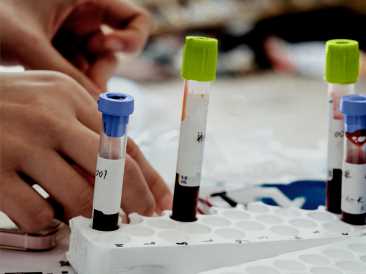
- Brain imaging and spinal fluid tests are two of the most common ways scientists detect early signs of Alzheimer’s disease [AD] in people.
- However, some of these tests are expensive, invasive, and not routinely available to the millions of individuals who may be at risk of this neurodegenerative condition.
- Now, a blood test developed by researchers at Washington University School of Medicine, St. Louis, has shown promising results in detecting the early signs of AD.
Randall Bateman, M.D. — the Charles F. and Joanne Knight Distinguished Professor of Neurology — and colleagues set out to determine the diagnostic accuracy of a new blood test for detecting early signs of AD.
AD occurs due to the accumulation of beta-amyloid, a protein that clumps together to form “sticky” plaques on the brain. These plaques affect the transmission of brain cell signals and may result in the death of brain cells, leading to symptoms of AD. These symptoms include memory loss, mood changes, and difficulties with speech.
Two of the most problematic proteins are beta-amyloid 40 and beta-amyloid 42 because health experts believe they contribute the most to the creation of sticky plaque.
The new study, which appears in the journal Neurology, started with a basic question about beta-amyloid production, its clearance in people, and why amyloid plaques develop as individuals get older and develop AD.
“We launched our study to measure that amyloid-beta 42 is specifically impaired in its clearance out of the brain and central nervous system,” senior study author Dr. Bateman explained to Medical News Today.
They then looked at the formation of beta-amyloid 42 and how it traveled from the brain into the blood.
“[W]e tracked how amyloid-beta is removed from the [central nervous system (CNS)], showing ~50% is removed across the blood-brain barrier to the blood,” he added. This then led to the discovery that looking at the ratio of amyloid-beta 42 and amyloid-beta 40 could identify whether or not somebody was forming amyloid plaques on their brain.
“From this discovery,” he added, “we sought to test and validate [our findings] in several large national Alzheimer’s disease studies, and the current publication in Neurology is that work from studies in Europe, the U.S., and Australia.”
Harmonizing diagnostic categories
Dr. Bateman and colleagues recruited participants from the Alzheimer’s Disease Neuroimaging Initiative (ADNI), the Australian Imaging, Biomarkers and Lifestyle Study (AIBL), and the Swedish BioFINDER study.
The research team selected participants with at least one stored plasma sample and a brain imaging scan within 1 year of sample collection. The scientists performed this regardless of the cognitive condition of the individual.
Each cohort had a different diagnostic classification for its members.
The ADNI cohort had cognitively unimpaired (CN), significant memory concern (SMC), and mild cognitive impairment (MCI) categories.
The AIBL cohort included CN, MCI, and AD and dementia categories.
The BioFINDER cohort included CN, MCI, and subjective cognitive decline (SCD) categories.
Throughout the study, the scientists defined cognitive impairment as the “objective evidence of cognitive impairment, rather than by subjective symptoms.” This was done to harmonize the various diagnostic classifications.
By the end of the study, individuals with SMC and SCD were included in the cognitively unimpaired category, while the cognitively impaired category included individuals with MCI and AD dementia.
An accurate sampling method
The team’s findings revealed that across all samples, the blood test was effective in predicting the presence of beta-amyloid in the body.
In addition, when the researchers considered the presence of a particular variant of the gene APO ε4, a known genetic risk factor for Alzheimer’s, alongside the blood test, they achieved an even higher degree of accuracy for predicting AD.
“These results suggest that plasma [beta-amyloid] with APOE ε4 status would be helpful for both screening cognitively unimpaired individuals for potential enrollment in AD secondary prevention clinical trials and testing cognitively impaired individuals in the clinic to determine whether AD is the probable etiology,” conclude the researchers.
“The fact that the blood test performed well across [different cohorts study designs and people] indicates that it is a robust measure of amyloid plaques and can be used in a variety of settings,” they add.
Reactions to the study
Dr. Jennifer Bramen, Ph.D., a senior research scientist at the Pacific Neuroscience Institute, Santa Monica, CA, who was not involved in the research, explained the study findings to MNT.
She said:
“Until recently, patients have relied on expensive tests like positron emission tomography to measure amyloid levels in the brain. A well-validated, blood-based test of [beta-amyloid 42/40] […] may be more accessible to patients and could aid in the diagnosis of Alzheimer’s disease.”
Despite this positive reaction, the research is not without its limitations.
The authors write that a major limitation was the low diversity among their sample sizes. As such, they are unclear if their findings apply to wider demographics.
However, the researchers also write that further studies to address these issues are underway.
Until then, they are delighted that their research has presented a potentially more affordable and time-saving alternative for detecting AD in individuals.
Source: Read Full Article
